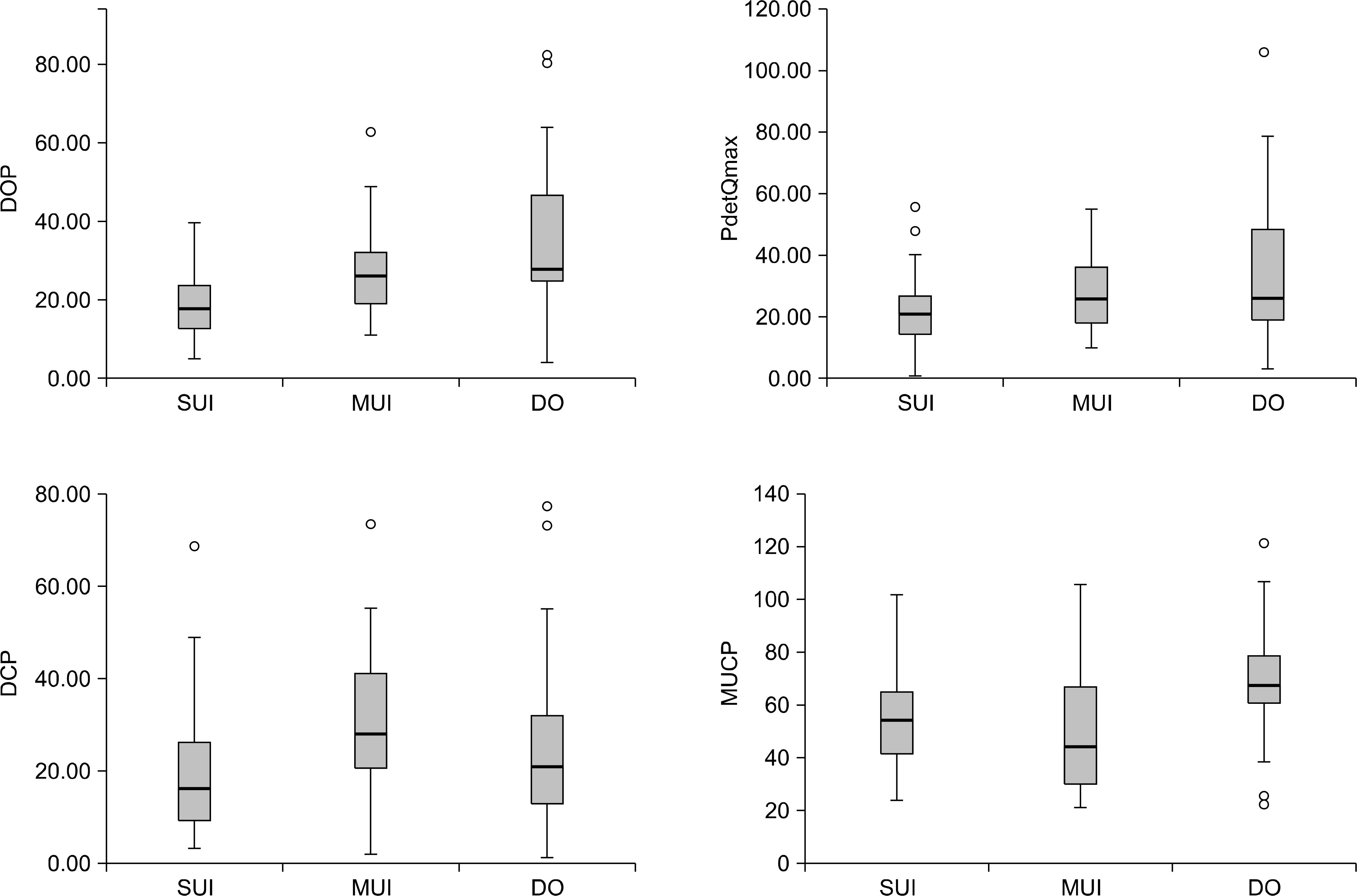Korean J Urol.
2009 Jun;50(6):567-572. 10.4111/kju.2009.50.6.567.
The Relationship of Pressure-Flow Parameters and Urethral Pressure in Female Patients with Lower Urinary Tract Symptoms
- Affiliations
-
- 1Department of Urology, National Medical Center, Seoul, Korea. soken@naver.com
- KMID: 1989788
- DOI: http://doi.org/10.4111/kju.2009.50.6.567
Abstract
-
PURPOSE: This study aimed to evaluate the relationship between pressure-flow parameters and urethral pressure in women with lower urinary tract symptoms (LUTS).
MATERIALS AND METHODS
Urodynamic traces of women with stress urinary incontinence (SUI), mixed urinary incontinence (MUI), and detrusor overactivity (DO) were retrospectively studied. The urodynamic parameters such as detrusor opening pressure (DOP), detrusor pressure at maximum flow rate (PdetQmax), maximum flow rate (Qmax), detrusor closing pressure (DCP), and maximal urethral closing pressure (MUCP) were measured and compared. The relationship between pressure-flow parameters and MUCP were evaluated as well as the differences between each urodynamic group.
RESULTS
One hundred fifty-one women were investigated between June 2004 and May 2008. One hundred twenty-one (80%) women had good-quality urodynamic studies and were included in the present study. The mean age was 56 years (range, 32-77). Women with DO had higher DOP, PdetQmax, and MUCP than did women with SUI (p<0.05). Qmax was significantly greater in women with SUI than in women who had DO (p<0.05). Women with MUI had DOP, PdetQmax, and Qmax that were intermediate between women with SUI and those with DO. There was a significant positive correlation between DOP, PdetQmax, DCP, and MUCP measurements and a significant negative correlation between Qmax and MUCP measurements (p<0.01).
CONCLUSIONS
Pressure-flow parameters are reliable surrogates of urethral pressure. Therefore, an accurate evaluation of the pressure-flow parameters might give important information in the assessment of urethral and detrusor function in women with LUTS. Further study is needed to confirm our results.
Keyword
MeSH Terms
Figure
Reference
-
1.Jarvis GJ., Hall S., Stamp S., Millar DR., Johnson A. An assessment of urodynamic examination in incontinent women. Br J Obstet Gynaecol. 1980. 87:893–6.
Article2.Won YY., Kim YS., Choi JB. The clinical role of cystourethrography and urodynamic study in patients with stress urinary incontinence. Korean J Urol. 2004. 45:120–4.3.Digesu GA., Khullar V., Cardozo L., Salvatore S. Overactive bladder symptoms: Do we need urodynamics? Neurourol Urodyn. 2003. 22:105–8.
Article4.Yun HC., Lee JG. Is urodynamic evaluation necessary for women with stress urinary incontinence? Korean J Urol. 2002. 43:687–92.5.Digesu GA., Hutchings A., Salvatore S., Selvaggi L., Khullar V. Reproducibility and reliability of pressure flow parameters in women. BJOG. 2003. 110:774–6.
Article6.Wagg AS., Lieu PK., Ding YY., Malone-Lee JG. A urodynamic analysis of age associated changes in urethral function in women with lower urinary tract symptoms. J Urol. 1996. 156:1984–8.
Article7.Tanagho EA. The anatomy and physiology of micturition. Clin Obstet Gynaecol. 1978. 5:3–26.
Article8.Nitti VW., Tu LM., Gitlin J. Diagnosing bladder outlet obstruction in women. J Urol. 1999. 161:1535–40.
Article9.Kim H., Lee U., Lee M., Choo MS. Cut-off value for bladder outlet obstruction in pressure-flow study in female: a prospective study. Korean J Urol. 2001. 42:1146–51.10.Abrams P., Blaivas JG., Stanton SL., Andersen JT. Standardisation of terminology of lower urinary tract function. Neurourol Urodyn. 1988. 7:403–27.
Article11.Karram MM., Partoll L., Bilotta V., Angel O. Factors affecting detrusor contraction strength during voiding in women. Obstet Gynecol. 1997. 90:723–6.
Article12.Cucchi A. Sequential changes in voiding dynamics related to the development of detrusor instability in women with stress urinary incontinence. Neurourol Urodyn. 1999. 18:73–80.
Article13.Lemack GE., Baseman AG., Zimmern PE. Voiding dynamics in women: a comparison of pressure-flow studies between asymptomatic and incontinent women. Urology. 2002. 59:42–6.
Article14.Bhatia NN., Bergman A., Karram M. Changes in urethral resis-tance after surgery for stress urinary incontinence. Urology. 1989. 34:200–4.
Article15.Slack M., Culligan P., Tracey M., Hunsicker K., Patel B., Sum-eray M. Relationship of urethral retro-resistance pressure to urodynamic measurements and incontinence severity. Neur-ourol Urodyn. 2004. 23:109–14.
Article16.Athanasiou S., Khullar V., Boos K., Salvatore S., Cardozo L. Imaging the urethral sphincter with three-dimensional ultrasound. Obstet Gynecol. 1999. 94:295–301.
Article17.Minardi D., Piloni V., Amadi A., El Asmar Z., Milanese G., Muz-zonigro G. Correlation between urodynamics and perineal ultrasound in female patients with urinary incontinence. Neu-rourol Urodyn. 2007. 26:176–82.
Article18.Ku JH., Oh SJ. Comparison of voiding parameters in men and women with lower urinary tract symptoms. Neurourol Urodyn. 2006. 25:13–8.
Article19.Yu JW., Yoon CY., Lee JG. Correlations of postoperative voiding difficulty and preoperative urodynamic and clinical parameters in stress urinary incontinence. J Korean Continence Soc. 2000. 4:40–7.
Article20.Digesu GA., Khullar V., Cardozo L., Sethna F., Salvatore S. Preoperative pressure-flow studies: useful variables to predict the outcome of continence surgery. BJU Int. 2004. 94:1296–9.
Article
- Full Text Links
- Actions
-
Cited
- CITED
-
- Close
- Share
- Similar articles
-
- The Effect of a 6Fr Transurethral Catheter on the Urinary Flow in Female Pressure-Flow Studies
- The Effect of Urethral Catheter on Pressure-Flow Study
- The Relationship of Prostatic Urethral Obstruction of Cytourethroscopy with Voiding Symptoms and Prostate Volume in Lower Urinary Tract Symptoms Patients
- A Comparison of Stress Leak-Point Pressure and Maximal Urethral Closure Pressure in Patients with Genuine Stress Incontinence
- Urinary Prostaglandin E in Female Urethral Syndrome


